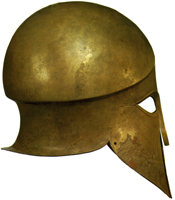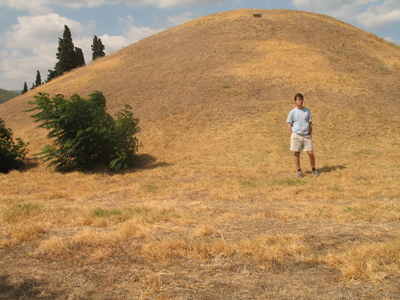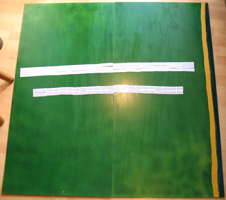
Focus of the workshop: Greek hoplites, their weapons, armour, and tactics; battle formations - the phalanx; the Battle of Marathon - background & sequence of events.
National Curriculum Topics covered: the Battle of Marathon; city states
Main Activities:
1. Learn about hoplite arms and methods using pictures and re-enactment
2. Make helmets and shields
3. Learn about Battle of Marathon through pictures, debate and battle strategy
4. Go outside to try marching and battle formations
'Very informative and practical' - Y5 teacher, St. Hilda's Primary
'Fantastic - the children thoroughly enjoyed themselves' - Y5 teacher, Mossley CE, Congleton More comments from teachers and children
Background information on: Hoplite arms and tactics The Battle of Marathon

The Greek Warfare Workshop lasts all day, and takes place in your classroom and the school playground (or hall if wet). Suitable for year 5-6.
Fee: £239 per class. Max. 32 children.
To Book: email Tony North at tnorth67@hotmail.com or tel: 0161 224 6445
Photos from Workshops:
Subject Matter
Morning Session

INTRODUCTION

What was a hoplite? The phalanx formation
What evidence could we use to learn about the weapons and armour of the Greek hoplite?
Time: 10 minutes
Photo from the movie '300' showing a Spartan phalanx
Large painting of hoplite
HOPLITE ARMS


Learn about the weapons and armour of the hoplite - spear, shield, helmet, greaves, cuirass, sword. Why did they hoplites paint designs on their shields?
Learn how these arms were used by the individual, and in the rank and file (the phalanx)
Why was the hoplite army so effective?
What were the values of the hoplite?
What modern reconstructions can we look at?
Time: 30 minutes
Ideally we will have break from 10.15-10.30.
Photos of vase paintings, sculpture, bronze statues, and artefacts
Photos of hoplite re-enactors
Game - name the weapons and armour in a vase painting of a hoplite, or a photo of a hoplite re-enactor
Game - identify artefacts in museums
Re-enactment: One volunteer will try out some replicas of arms and I will teach them how they were used, in marching and combat. Three volunteers will pretend to be in ranks and files. Then nine will form a phalanx, and we will see why the phalanx was so strong.
MAKE HELMETS AND SHIELDS

Children will make copies of helmets and shields. They will be divided into groups of four, and each group will make one set. This is a challenging activity, suitable for year 5-6s and very able year 4s. Extra support will be needed, especially with younger children.
Shiny bronze and thick white card will be used, and templates for drawing round and cutting out, followed by sticking with glue, tape, and staples. Children will draw designs on their shields with markers.
Time: 90-120 minutes (we will probably need up to 20 minutes of the afternoon session to finish)

Materials provided by me: bronze card, thick white card (for the shield rims), thin card for helmet crests (choice of red, white and black), templates, double sided tape, staplers, sellotape, rope, plasticine, large scissors, pencil sharpeners, permanent markers
Materials provided by the school: Pritt sticks, scissors, pencils, erasers, paint, palettes, marker pens for the shield rims and helmet crests, brushes, pots for water
left: helmet made at Peacefield Primary School, Marple, March 2009.
Note: the craft activity is too difficult for some classes. The Greek Legacies craft activity (making a model of a temple) is easier.
Afternoon Session
THE BATTLE OF MARATHON

The burial mound of the 192 Athenians who died at Marathon
Background to the Battle of Marathon, 490BC. This was the first battle of the wars between Greece and Persia. Despite overwhelming odds the Athenian army won a stunning victory. The runner Philippides was sent 146 miles to Sparta to ask for help - which did not come in time. We will look at maps and discuss the threat of Persia.
We look at the weapons and armour of the Persian army. Children imagine how an Athenian at the time would have felt facing such a large and successful invading army.
Time: 20 minutes
Maps of Greece and Persian Empire, and Marathon area
Pictures showing sculptures and paintings of Persians, Persian shields.
Photos of the Marathon area.
DEMOCRATIC ROLE-PLAY and BATTLE STRATEGY
 Persian archer
Persian archer
The class pretends to be the democratic assembly of Athens, debating and voting on an important question related to the Persian invasion, i.e. whether to fight the Persians or give in.
Then the class pretends to be the Athenian generals and tries to work out the best strategy to deal with the following problems:
- the many thousands of archers in the Persian army
- the greater size of the Persian army, which will outflank the Athenians
- what to do after the battle when the Persian fleet is seen sailing south towards Athens
Time: 50 minutes
Discussions and voting on these questions
I will tell them the consequences of their decisions, and what the Athenians actually did
We will use a board and plastic pictures representing sections of the two armies to try out different battle formations, and learn what result each would lead to. (See board below)

BATTLE RE-ENACTMENT
We now go out onto the field/playground (or hall if wet) and reenact the attack at Marathon. Children are divided into four teams and each tries the following exercises, with a contest to see who can drill in the most orderly way:
- holding spear and shield correctly, marching, and advancing to fight
- running to avoid arrows and forming phalanx at the battle line.
The children in the other 3 teams pretend to be the Persians, firing arrows.
After this we will return to class and discuss the experience of battle reenactment. I will also take any questions.
Time: 30+ minutes
Note: I am no longer doing the battle reenactment involving other classes, for two reasons:
1. The helmet and shield making always takes most of lunch time to finish, meaning we do not get much of a break.
2. In most workshops, by the end of the day children are very excited, and with the presence of other classes their ability to listen and follow instructions is significantly impaired. Also, occasionally some children become too aggressive.
Children will use the helmets and shields they made earlier, so we have four groups in all who will take it in turns. I shall provide spears.
Children will wear their normal clothes underneath.
I will also show the class my 8 foot replica of a hoplite spear.

children in a phalanx at St Mary's Primary in
Davyhulme